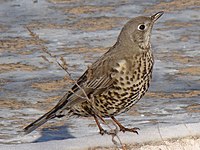
Photo from wikipedia
Abstract—The foraging behavior of the blackbird and fieldfare in the city of Kaliningrad was studied. The similarity of the feeding habitats used by the thrushes is noted. The main type… Click to show full abstract
Abstract—The foraging behavior of the blackbird and fieldfare in the city of Kaliningrad was studied. The similarity of the feeding habitats used by the thrushes is noted. The main type of fodder habitats during the reproductive period are lawns with low vegetation cover, rarefied as a result of human influence, while they are squares and gardens with fruit bushes and trees during the autumn and winter period. The use of fodder habitats and fodder objects of anthropogenic origin is noted for the blackbird out of its period of reproduction. The differences in nutrition behavior consist in the frequency and sequence of the use of foraging acts and are associated with the thrushes’ use of various quantities of objects from the soil and from its surface. During the breeding season, sweeping motions of the beak are the most characteristic for the blackbird, and digging up objects from the soil is typical for the fieldfare. The differences in the foraging behavior of the thrushes in Kaliningrad (in contrast to natural habitats) are expressed as an increased variety of the foraging methods used and a significantly prolonged duration of examination for the blackbird and fieldfare, respectively. These differences are due to the manifestation of specific features in specific places of feeding.
Journal Title: Biology Bulletin
Year Published: 2019
Link to full text (if available)
Share on Social Media: Sign Up to like & get
recommendations!